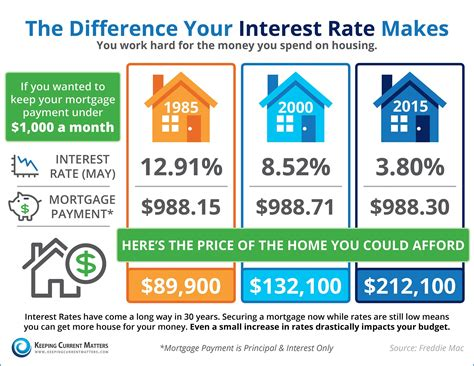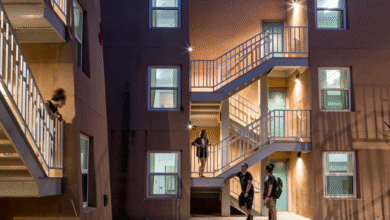Mortgage Demand Drops 10% Amid Rising Rates and Economy

Mortgage demand has seen a significant decline recently, dropping by 10% in just one week as rising mortgage rates and growing economic concerns put pressure on potential homeowners. The average contract interest rate for 30-year fixed-rate mortgages, now at 6.82%, has deterred many buyers from entering the housing market. Compounding this issue, applications for purchasing a home decreased by 12% compared to the previous week, underscoring a shift in buyer sentiment. Even applications for home refinancing are feeling the pinch, reflecting a 7% drop, although they remain higher than last year’s figures. As the landscape evolves, both consumers and investors are watching closely, weighing the impacts of fluctuating interest rates on their future homeownership plans.
The recent downturn in home financing requests highlights a critical moment in the real estate sector. With an evident slump in home purchase applications and refinancing requests, many are questioning the current stability of the property market. As financial conditions tighten and interest rates rise, the implications for both property buyers and sellers could be profound. Economic anxiety seems to be influencing decision-making among consumers, prompting individuals to reevaluate their objectives amidst changing market dynamics. This shift may indicate a broader recalibration within the realm of home financing and investment in real estate.
Understanding Mortgage Demand Trends
The recent trends in mortgage demand reveal a significant decrease as economic conditions fluctuate. Last week witnessed a 10% drop in overall mortgage applications, a concerning indicator for the housing market. According to the Mortgage Bankers Association, this decline was primarily triggered by rising interest rates and increasing economic uncertainties, such as concerns over tariffs and inflation. While demand for purchasing homes has fallen, it is essential to recognize that applications were still 13% higher compared to the same week last year, indicating ongoing interest in the housing market despite current challenges.
Many potential buyers are experiencing hesitance due to higher mortgage rates, which recently increased to an average of 6.82% for 30-year fixed-rate loans. This rise has made home financing less attractive, contributing to the decrease in applications for new mortgages. Interestingly, the mortgage demand for refinancing also saw a drop of 7%, although it remains 25% higher than last year. This juxtaposition reflects the complexity of current economic conditions and their impact on the housing market.
The Impact of Rising Mortgage Rates
The rise in mortgage rates has had a pronounced effect on consumer behavior regarding home buying and refinancing. As rates climbed last week, applications for new mortgages dropped significantly. The average contract interest rate for 30-year fixed-rate mortgages with a loan size of $806,500 or less went up to 6.82%, leading to a diminished appetite among potential buyers who are cautious about affordability. This presents a challenge for the housing market as higher costs deter new buyers and slow down home sales.
Moreover, the increasing rates are not only affecting the purchase applications but also the refinancing sector. The 7% drop in refinance applications indicates that many homeowners are deciding against refinancing their existing mortgages, particularly when interest rates are high. As the housing market enters a phase where prices are softening, higher mortgage rates compound the issue, making it a precarious environment for both buyers and sellers.
Economic Concerns and Housing Market Dynamics
Economic concerns, especially regarding tariffs and inflation, have significant implications for the housing market. Recent increases in Treasury yields were driven partly by these economic fears, subsequently causing mortgage rates to rise. As potential sellers withdraw from the market, influenced by higher mortgage rates and a perceived decline in buyer demand, the housing market risks stagnation. The inventory levels have risen this year, but the combination of rising rates and economic uncertainty may create a standoff between buyers and sellers.
This scenario showcases the delicate balance within the housing ecosystem. Even with a 12% dip in new mortgage applications, last year’s comparative figures show resilience, as demand remains appreciable over a longer timeline. However, as economic concerns loom large, buyers may find themselves holding back, further impacting market liquidity and price stabilization. It emphasizes the need for careful navigation through these fluctuating economic conditions.
Refinancing Trends Amid Economic Shifts
Refinancing trends offer a telling glimpse into homeowner sentiment amidst rising interest rates. Although refinance applications decreased by 7% last week, they are still significantly up by 25% from a year ago. This suggests that while higher rates are cooling immediate refinancing activity, many homeowners still recognize the benefits of refinancing, particularly given the competitive rates available earlier in the year. Nonetheless, the notable 22% decline in VA refinancing points to the pressures that rising costs are exerting on even those with potentially favorable loan conditions.
Moreover, the fluctuations in refinancing activity reflect broader economic sentiments. Homeowners are reportedly weighing their options carefully, knowing that while they may still achieve savings through refinancing, the associated costs may now outweigh the benefits as interest rates increase. This complexity could lead many to delay refinancing, especially in light of current economic uncertainties, leading to a more cautious approach within the housing finance sector.
Decoding the Housing Market’s Future
The future of the housing market hinges significantly on the trajectory of mortgage rates and prevailing economic conditions. Current trends indicate that as mortgage rates continue to rise in response to economic pressures, the slowdown in mortgage applications may persist. The delicate equilibrium between buyer interests and seller expectations will ultimately determine market stability. Given the previous year’s strong demand, the current dip may simply be a momentary phase influenced by financial caution.
On the other hand, the persistent rise in larger loan amounts suggests that some buyers are still willing to enter the market, despite the challenges posed by heightened rates. Lenders may need to adjust their strategies to cater to evolving consumer needs, particularly as demand shifts towards more favorable lending conditions. Overall, navigating these challenges will require resilience and adaptability within the housing market to foster future growth.
The Role of Treasury Yields in Mortgage Rates
Treasury yields play a pivotal role in shaping mortgage rates, directly influencing the cost of borrowing for prospective homebuyers. Recently observed spikes in Treasury yields, driven by escalating economic concerns, have led to accompanying increases in mortgage rates, which hit an average of 6.82%. This relationship underscores how external economic influences can create ripples throughout the housing market, affecting both borrowing costs and consumer behaviors in mortgage applications.
With Treasury yields expected to remain volatile due to ongoing economic adjustments, borrowers must keep a close watch on rate movements. Higher yields typically showcase increased borrowing costs, which could deter potential buyers from making large financial commitments. As such, understanding the intricacies of Treasury yields becomes crucial for anyone navigating the current mortgage landscape and considering their financial decisions regarding home purchases or refinances.
Consumer Sentiment in a Challenging Market
Consumer sentiment is crucial in a fluctuating housing market, particularly as higher mortgage rates introduce new challenges for homebuyers. Many prospective purchasers may feel uncertain amid ongoing economic shifts, leading to hesitation in making significant financial investments. This sentiment is mirrored in the recent statistics showing a 10% decrease in overall mortgage applications, as individuals weigh risks tied to variable economic conditions.
Furthermore, as economic concerns such as concerns about inflation and tariffs influence purchasing power, potential homebuyers may adopt a wait-and-see approach. This caution can further contribute to sluggish demand in the housing market, reinforcing the cycle of reduced consumer activity as rates continue to climb. Thus, it’s vital for lenders to understand current consumer sentiments in order to develop strategies that can attract and retain borrowers during these challenging times.
Navigating the Future of Home Buying
As the housing market continues to experience fluctuations, navigating the future of home buying will require awareness and strategic planning. Prospective buyers must be diligent in understanding the various components, including current mortgage rates, economic indicators, and market trends that influence pricing and buying power. This comprehensive awareness allows individuals to better position themselves, whether they decide to buy now or wait for more favorable conditions.
Additionally, as economic concerns loom, educating oneself on alternative financing options can be essential. First-time homebuyers, in particular, may benefit from exploring various loan products that suit their needs while still considering potential future rate changes. The housing market’s uncertainty calls for proactive engagement from buyers to ensure they can capitalize on opportunities while mitigating risks associated with their home purchase plans.
Long-Term Effects of Current Market Conditions
The long-term effects of current market conditions will be shaped significantly by the interplay between interest rates and economic fluctuations. As the demand for mortgages dips in response to rising rates, a shift in buyer behavior can reshape the landscape of the housing market over time. While today’s figures show a decline, it is essential to consider the cyclical nature of real estate and how trends may bounce back as economic conditions stabilize.
Home prices may also adjust in response to decreased buyer demand, which could ultimately open avenues for entry-level buyers looking for affordability in the future. The extent to which current economic uncertainties will impact the housing market in the long run remains to be seen, but awareness of these dynamics is crucial for potential buyers, sellers, and investors as they move forward in navigating this evolving environment.
Frequently Asked Questions
How are current mortgage rates affecting mortgage demand?
Current mortgage rates, averaging 6.82% for 30-year fixed-rate mortgages, have significantly impacted mortgage demand. As rates rise, applications to purchase homes have dropped by 12%, indicating that higher costs deter potential buyers from entering the housing market.
What is the trend in housing market mortgage demand this week?
This week saw a 10% decrease in total mortgage application volume, primarily due to rising interest rates and overall economic concerns. Despite this drop, applications are still 13% higher compared to the same week last year.
How do economic concerns influence mortgage demand?
Economic concerns, particularly related to tariffs, have led to higher Treasury yields, which in turn increased mortgage rates. This escalation in rates has contributed to a decline in mortgage demand as both purchase and refinance applications fell.
Is refinancing still in demand even with rising mortgage rates?
Despite rising mortgage rates, refinance applications remain 25% higher than last year. However, there was a 7% decrease this week as higher rates specifically impacted VA refinancing applications, which fell 22%.
What factors contribute to the slowdown in the housing market’s mortgage demand?
The slowdown in mortgage demand can be attributed to several factors, including rising mortgage rates, economic uncertainty, and a decrease in buyer demand as home prices show signs of softening. Increased inventory has not incentivized buyers sufficiently in this economic climate.
How do mortgage rates affect home refinancing applications?
Mortgage rates have a significant effect on home refinancing applications. When rates increase, as we’ve seen recently, the number of homeowners looking to refinance typically decreases, leading to a drop in applications, as seen with a 7% decline this past week.
What is the relationship between mortgage rates and the housing market?
Mortgage rates are closely tied to the housing market. As rates rise, mortgage demand tends to decline, making it more expensive for prospective buyers to secure home loans. This often leads to a slowdown in housing market activity.
Will rising mortgage rates continue to affect housing market demand?
Yes, if mortgage rates continue to rise, we can expect further impacts on housing market demand. Higher rates can lead to fewer buyers entering the market, resulting in a slowdown in applications and potential price stabilizations or drops.
| Key Points |
|---|
| Average mortgage rate for 30-year fixed-rate mortgages increased to 6.82% from 6.77%. |
| Mortgage applications to purchase a home fell by 12% weekly but are 13% higher from last year. |
| Refinance applications decreased by 7% weekly and are 25% higher than the year before. |
| Renewed economic concerns, particularly tariffs, impacted Treasury yields and subsequently mortgage rates. |
| Jumbo loan rates have been lower than conventional rates for three weeks, indicating shifts in market strategy. |
| Despite higher mortgage rates, some experts note the market’s response to inflation is complex. |
Summary
Mortgage demand has significantly decreased, experiencing a 10% drop over the past week. This decline can be attributed to increasing mortgage rates, now at an average of 6.82%, and prevailing concerns regarding the economy and tariffs. Despite this recent decline, mortgage applications remain higher than they were a year ago, suggesting that year-over-year comparisons show underlying resilience in the housing market. Overall, the landscape for mortgage demand continues to evolve in response to economic indicators.




